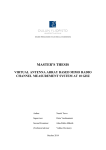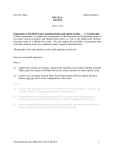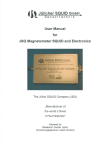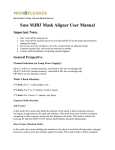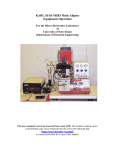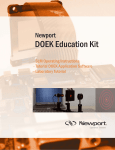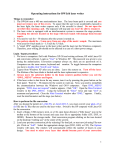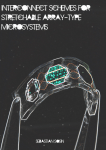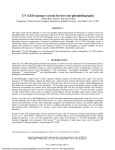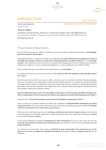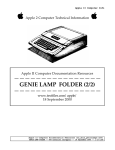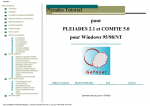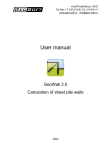Download Lithography in Experimental Environment
Transcript
Reports in Electron Physics 2000/21 Espoo 2000 Lithography in Experimental Environment Anssi Hovinen Alexei Malinin Antti Lipsanen Reports in Electron Physics 2000/21 Espoo 2000 Lithography in Experimental Environment Anssi Hovinen Alexei Malinin Antti Lipsanen Helsinki University of Technology Department of Electrical and Communications Engineering Electron Physics Laboratory Teknillinen Korkeakoulu Sähkö- ja tietoliikennetekniikan osasto Elektronifysiikan laboratorio Distribution: Helsinki University of Technology Electron Physics Laboratory P.O. Box 3000 FIN-02015 HUT Tel. +358-9-451 2322 Fax. +358-9-451 5008 E-mail: [email protected] ISBN 951-22-4887-5 ISSN 0355-5712 Libella Painopalvelu Oy Espoo 2000 1. INTRODUCTION .........................................................................................................................1 2. THE EXPERIMENTAL ENVIRONMENT ...............................................................................2 3. DIFFRACTION.............................................................................................................................3 4. BASIC LITHOGRAPHY STEPS FOR AZ5214E......................................................................6 4.1. 4.2 4.3. 4.4. 4.5. 4.6. 4.7. SAMPLE PREPARATION ................................................................................................................6 ADHESION BETWEEN RESIST AND SAMPLE ..................................................................................6 SPINNING OF THE RESIST .............................................................................................................8 PREBAKING OF THE RESIST..........................................................................................................8 EXPOSURE ...................................................................................................................................9 DEVELOPMENT ..........................................................................................................................12 POSTBAKING OF THE RESIST ......................................................................................................13 5. IMAGE REVERSAL AND REVERSAL BAKING .................................................................13 6. PLANARISATION OF SHALLOW HILLS ............................................................................14 7. DOUBLY PATTERNED TWO LAYER LITHOGRAPHY....................................................14 8. CONCLUSION............................................................................................................................16 9. REFERENCES ............................................................................................................................17 Electron Physics Laboratory Helsinki University of Technology 1. Reports in Electron Physics 2000/1 Introduction Laboratory work is often claimed rather monotonous. A typical experimental setup consists of a piece of paper, a worker preferably with a pencil, and some equipment for doing the experiment. On his paper the worker may have a list of steps that should guide the experiment to a satisfactory result. In an ideal case the worker understands fully the actual meaning of the instructions on the paper. Ideally, he also understands the limitations and non-idealities of the equipment so that he can do his work being aware of the differences in what he wishes to do and what is actually happening during the experiment. He then can use his pencil to write down the differences for future reference, and perhaps even gain some useful information from his experiment. The gap between what a worker wishes to do and what he can do with his equipment should be kept minimal. Excluding the two extremes of a perfect equipment with a capability of correctly doing what ever a worker wishes and an ideally aware and observant worker, there is always at least a small degree of mismatch between the workers wishes and the experimental result. The art of practice is about gaining the information from the experiment despite the observed non-idealities of the tool. A lithography room is a very heavily used tool in experimental work with semiconductors. A laboratory scale lithography room is seldom an ideal environment for experiments. It is therefore of crucial importance that the worker is aware of the tool related complications that he faces when he enters the lithography room. Even a simple lithography with round wafers, loose alignment tolerances and line widths of several micrometers can become a living nightmare for the worker, if the basic guidelines of lithography are not fully understood. This understanding becomes a necessity for those of us who wish to do their experiments with non-symmetrical, small area or otherwise more cumbersome samples, that may be made of something more exotic material than silicon. This booklet was written with emphasis on the methods and principles that have been common practice for the lithography room users in H.U.T. electron physics laboratory for some years. In an attempt of giving deeper insight into the experimental lithography work, the reasoning behind methods described here is illustrated when possible, with reference to the experiments that led to the adoption of the method. It should be pointed out that a specific laboratory practice cannot be transferred from a working place to another without at least some modification, rising from the difference in environments. This includes, e.g., differences in actual oven temperatures and fan speeds, exposure calibration, actual spinner speeds, temperature difference of clean room water, lithography room temperature and humidity control. I hope that this booklet gives the worker in the lithography room something to think about while stepping through the seemingly monotonous and boring lithography instructions. 1 Electron Physics Laboratory Helsinki University of Technology 2. Reports in Electron Physics 2000/1 The Experimental Environment On the following section the concept of an experimental environment is enlarged from the clean room users level to the level of a sample under experiment. Although it is worth knowing that the overall clean room air is of class X, more important for the experiment is what happens in the sample vicinity in that clean room. One of the most basic errors one can make during the preparation of an experiment that includes some lithography is to rush making some basic lithography according to a proven-to-be-good recipe that originally was for silicon wafers, without first considering whether the sample under study is suitable for lithography at all. An important part of lithography is spin coating of the resist on the sample. Taking a spinner with a vacuum chuck and AZ5214E for resist, it involves typically 4000 rpm rotation and yields a resist film of only 1,5 um thickness. For a sample, we need surface roughness of far less than 1,5 um, size enough that the vacuum chuck is not leaky, reasonably light weight so that the vacuum chuck can hold the sample, and shape such that the sample can be centred to the chuck to ensure vibration free spinning. When mount to the vacuum chuck, the sample surface should be horizontal. The forces that a vacuum chuck generates can easily bend a flexible sample and make uniform coating rather difficult. If the sample surface contains narrow wells that are deeper than about 2 um, the AZ5214E resist perhaps fills the well, but the bottom parts of the resist wont dry enough to be sensitive to light for exposure. Chemically, the sample should not react the common chemicals that are used during the lithography. As an example, aluminium thin films can easily be removed with common developers used for AZ5214E. The lithography also involves baking, with typically 90 0C or more. A sample that can not stand heat, cannot be patterned with the basic proven-to-be-good recipe. Workers in a lithography room wish usually not to introduce any particles over their samples. A particle stuck on a sample surface can easily be revealed after resist spin by the radial oriented coloured traces. If not originally on the surface, the particle might have come from the resist bottle, or from the surrounding air just before spin coating. If the sample was cut from a semiconductor wafer, it is practically impossible to prevent it from cracking further on its periphery, generating dust. When the sample is stored in its plastic box, it distributes the dust throughout the container and the surface of itself. Static charges on the plastic ensures that the dust stays there even if the box is blown clean with nitrogen. Fortunately, in laboratory scale experiments, yield is of secondary importance. We could be somewhat relaxed with the dust particles, if they did not enter in between the sample and exposure mask introducing a small gap there. In chapter 3 the gap is discussed further with diffraction. 2 Electron Physics Laboratory Helsinki University of Technology 3. Reports in Electron Physics 2000/1 Diffraction When a beam of light goes through a narrow slit its energy is redistributed because of diffraction. Basic mathematics for a light wave diffracting in a slit can be found, e.g., in [1] or [2]. Figure 1 gives a schematic representation of resist exposure through a narrow pattern in a mask. S is a point source of light, d is the gap between resist layer and mask, and b is the width of the pattern, and n is a unit vector perpendicular to mask. In lithography we are mainly interested on the dose of energy that a volume of resist will get during exposure. We would like to have sharp boundaries between illuminated and dark areas of resist. The dose of energy to a point of interest P on the surface of our resist layer can be calculated according to Huygens-Fresnel principle. The original principle by Huygens (1629-1695) of forming the wave front from superposition of point sources of wavelets on the line of slit was modified by Fresnel (1788-1827) with a statement that the secondary wavelets interfere with each other while forming the wave at point P. Kirchhoff (1832-1887) showed that the Huygens-Fresnel principle was an approximation of a more rigorous integral theorem [2]. Figure 1: Schematic representation of exposure through a narrow slit. S is point source of light, d is the gap between resist and mask, slit width is b. n is a unit vector perpendicular to mask. 3 Electron Physics Laboratory Helsinki University of Technology Reports in Electron Physics 2000/1 A monochromatic, spherically distributed light that is emitted from a point source S can be considered as a sinusoidal wave V(x,y,z,t) with frequency f and wavelength λ, scalar wave number k and a position dependent amplitude U(x,y,z), V ( x, y, z ) = U ( x, y, z ) ⋅ e −iωt , where ω = 2π ⋅ f = 2π c = kc. λ The constant c in the formula is for speed of light. The wave number k is a scalar, because the wave is assumed to be spherically symmetrical and no special direction is defined. The intensity of light is then I ( x, y, z ) = V ( x, y, z , t ) = U 2 ( x, y, z ). 2 The dose of energy E at a given point (x,y,z) is E ( x, y , z ) = I ( x, y , z ) ⋅ t , where t is the exposure time. Some necessary approximations should be made before trying to solve the dose of energy at a given point P. Kirchhoff’s boundary conditions in his diffraction theory put the wave amplitude U and its gradient ∇U to zero everywhere in the line of slit but between y=-b/2 and y=b/2. In between y=-b/2 and y=b/2 the amplitude and its gradient is put the same as they would be in the absence of slit. The FresnelKirchhoff integral formula is derived in [2] and relates the light amplitude at point P to the incident wave front at the slit line by an integral over the slit area. With a slit length L the Fresnel-Kirchhoff integral formula becomes U (P ) = − iAL e ikr e ikr ' ⋅ [cos(n, r ) − cos(n, r ')]dy r' 2λ ò r where A is a constant. When the source of light S is far away from the mask, or |r’| >> b , |r’| is approximately constant over integration, and cos(n,r’) equals -1. The integral then becomes iAL eikr ' eikr U (P ) = − [cos(n, r ) + 1]dy. 2λ r ' ò r 4 Electron Physics Laboratory Helsinki University of Technology Reports in Electron Physics 2000/1 Redistribution of energy along the surface of the resist layer can now be determined by repeating the above integration in all the points on resist surface. Figure 2 shows some calculated diffraction patterns for various mask gaps d with pattern width of 2,5 um. The light wavelength was 334 nm. The corresponding cross-sectional profiles of a typical resist after completion of the lithography are also shown in the figure. The simulations were made with an educational resist simulator designed and programmed in H.U.T. electron physics laboratory. It can be concluded from Figure 2 that for a successful lithography one has to minimise the gap between mask and resist in order to transfer the mask patterns to the resist with a reasonable accuracy. d = 0,1 um d = 0,5 um d = 1,0 um d = 3,0 um d = 9,0 um Figure 2: Some calculated diffraction patterns for various mask gaps d. The corresponding cross-sectional profiles of a typical resist after completion of the lithography are also shown. Pattern width on the simulations was 2,5 um and the light wavelength was 334 nm. 5 Electron Physics Laboratory Helsinki University of Technology 4. Reports in Electron Physics 2000/1 Basic Lithography Steps for AZ5214E The basic steps to make resist patterns on a sample can be found in many textbooks, e.g. [3], [4]. Here the scope is to pay attention to areas where we tend to mess up an experiment. In particular, the examples are given for GaAs-based samples of relatively small area and non-symmetrical shape. 4.1. Sample Preparation The sample surface is seldom ready as such for lithography. It is important to keep track on the sample history in such a way that a reasonable estimate about the residuals and contamination on the sample surface can be made. In laboratory environment one has to balance between minimum amount of exposure to contamination and manipulation of the sample and maximum amount of treatments to get the most out of the experiment. If the sample is to be etched after resist patterning, it might be a good idea to clean the surface prior to lithography. Or not, if the cleaning can be done after lithography without attacking the resist, thus saving one processing step. Cleaning of a semiconductor surface is not an easy task. Unless we are sure that the surface will be cleaner after the attempt to clean it, it should not be done. The cleaning is of no use, if the surface is allowed to be contaminated again before, or during, the next processing step. The resist itself can serve as a rather good shield against contamination during storage. Sometimes it might be a good idea not to remove the resist immediately, but just before the next processing step. In GaAs processing, cleaning of the sample surface prior to wet etching of mesa hills is of crucial importance. Wet chemical etching of a sample surface is an easy method of revealing any residuals on the sample surface. The areas where etching reactions are disturbed by residuals are attacked with different rate with respect to other areas. Differences in etching rates are readily seen in visual inspection of the etched surface. As an example of the shielding capability of the resist, a GaAs sample was successfully wet chemically etched after being stored for two years on a shelf with a resist coating on it. The cleaning step prior to etching consisted of only a rinse in acetone and a quick dip in the simple cleaning solutions used in HBT and HEMT processing. 4.2 Adhesion between Resist and Sample A typical source of frustration for a lithography worker is when just after finishing the tedious and lengthy patterning work he examines the result with a microscope and finds out that some or most of the resist patterns have floated off their original places and disappeared, or moved randomly. Almost always the failure originates from what have been, and have not been done between cleaning the sample surface and resist spinning. Sometimes the adhesion problem is not revealed immediately, but after, e.g., wet chemical etching of the sample, when the loose resist pattern periphery allows etchant to attack the area deep under the resist. Strain may be introduced into the resist during lithography that in an extreme case cracks resist partially off. Figure 3 shows an example of a failed resist pattern. 6 Electron Physics Laboratory Helsinki University of Technology Reports in Electron Physics 2000/1 Figure 3: A resist pattern that has ruptured off from silicon surface With AZ5214E resist the adhesion problems are mainly associated with water molecules that reside the surface of the sample [5]. For silicon dioxide and silicon nitride, there are two relatively easy ways to promote the adhesion. The sample is baked for a long time in high temperature to evaporate the excess water out, and then the surface is treated by hexamethyl disilazane (HMDS), that is either spin coated or evaporated in low pressure to the sample surface [6]. The purpose of the treatment is to introduce an intermediate layer of HMDS molecules between silicon atoms at the sample surface and the photoresist. HMDS surface layer is also effective in sealing the sample surface from moisture. After treatment, samples can be stored on shelf for several days without loosing the resist adhesion properties of the surface. The common procedure for oven baking is one hour in 120 0C, although that temperature is rather low if one wishes to remove a water molecule from a silicon surface. For convenience, the temperature is fixed the same as for post baking, to be able to use the same oven for both bakes without altering temperatures. It is of utmost importance to maintain the temperatures of the lithography ovens constant to conserve at least some of the repeatability of the overall processing. To promote the adhesion in other materials than silicon, one has to be aware whether the material needs to be baked at all or treated in HMDS. Even more so, one has to check out whether the material can stand the baking temperature and whether it is chemically resistant to HMDS. As a chemical, HMDS tends to decompose to silane and ammonium thus forming a very violent fuel, so it should not be treated as just an adhesion promoter of universal kind. A complication might arise from the HMDS tendency to reduce the photosensitivity of AZ5214E resist [5]. Especially with spin coating of HMDS, the sample might get too much of a dose of HMDS, and that will turn the bottom part of the resist optically inactive. This will then yield a very thin, uniform layer of resist that will not be removed during a normal development. Sometimes a relatively poor adhesion is even preferred. If the resist pattern consist mainly of small open areas with no narrow resist lines, and one wishes to make, e.g., a liftoff metallisation with it, the optimisation of adhesion should be of no concern. 7 Electron Physics Laboratory Helsinki University of Technology 4.3. Reports in Electron Physics 2000/1 Spinning of the Resist As a machine, the spinner is not as simple as it looks like. One of the most frequent troubles for the novice user of the spinner is that the chuck does not start to spin “what ever the worker tries to do”. For security reasons, the spinner with a vacuum chuck is constructed in a way that it will not rotate before a defined level of vacuum is present holding the sample tightly on the chuck. The chuck is fitted to spinners rotator with a rubber O-ring. The surface of the chuck is grooved so that the vacuum will be distributed under the sample more efficiently. If the spinner did not start, either the vacuum pump was shut off, the O-ring leaks, or the sample did not fill the grooves on the chuck surface. The worker should always choose a chuck of a proper grooving for his work, and while installing the chuck, check that the O-ring is present. When the leaky chuck problem is away, the worker can start to tackle the next one. It is not an easy task to align a sample to a vacuum chuck in such a manner that it will not generate vibrations during spinning of, e.g., 4000 rpm. But if one wishes to have uniformity in the resist film, the sample just has to be aligned. In long run, misaligned samples loosen also the spinner axis with the strong forces of vibrations and make the spinner useless for accurate work. Variations in the resist film thickness are readily seen in bare eye. Resist areas of different thickness are of different colour. A perfect spinning results in a resist layer with no coloured patterns. If the sample was not round in shape, resist will be inavoidably accumulated on the corner regions forming areas of very thick film. As was discussed in section 3, we have to minimise the gap between the mask and resist to avoid diffraction. The thick corner areas have to be removed later to make it possible to bring the mask closer to the resist surface in the central region of the sample. AZ5214E resist is not very sensitive to light until its solvent component (propylene glycol monomethyl ether acetate, PGMEA) is removed. The solvent diffuses out of the resist film rather slowly, so usually one wishes to accelerate the diffusion process by prebaking the resist in an oven or hot plate. To recall the basic properties of AZ5214E, the reader is encouraged to study references [5], [7], [8], [9], [10] and [11]. It is worth recalling especially that the final thickness of AZ5214E after a spinning of 4000 rpm for 25 seconds is about 1,4 um. The final thickness depends on the spinning speed like inverse of the square root of rpm in 1000 turns per minute. if the rpm is 1000 instead of 4000, the final thickness is twice as much, or 3 um. For AZ5214E, 3 um is beyond the practical limits [5], so if one wishes to operate with thicker resists, he needs to consider, e.g. AZ4620. 4.4. Prebaking of the Resist The common procedure for drying out PGMEA from the AZ5214E film is to bake the sample in an oven at 90 0C for 20 minutes, or 90 0C and 90 seconds in a hot plate. The time is a compromise between what is enough and how long it should be. It is reasonable to consider 20 minutes as the absolute minimum prebaking time in an oven [5]. It is very important to realise that there is a multitude of parameters and choices that alter the optimum baking procedure for a given sample. Sample temperature varies relatively slowly after it was put in oven. Even in a hot plate the temperature will not 8 Electron Physics Laboratory Helsinki University of Technology Reports in Electron Physics 2000/1 change immediately. A sample that is oven baked on top of an aluminium foil heats up differently than a sample that is vertically mount on a quartz boat. Thermal conductivity and absorption properties of GaAs differ from those of silicon. For a given material, the baking procedure has normally to be optimised separately. Finally, if one wishes to maximise the baking speed to save processing time, he will loose the repeatability of the process. It is not very good practice to use oven in baking steps that are, say, less than five minutes. After a successful prebake, the resist film is very sensitive to light that has proper wavelengths. For AZ5214E, the sensitive wavelengths are between 310 nm and 420 nm [8]. Prebaked AZ5214E-coated samples can be stored in normal yellow wafer boxes for several days, if for some reason the exposure is not done immediately. Sometimes it is preferred to have a stock of exposure-ready samples on the shelf. 4.5. Exposure The exposure machine is even more tricky than is a spinner. The main aim is to illuminate the photosensitive resist film through a mask that contains the desired pattern. The worker wishes that the areas that get illuminated turn very soluble to developer liquid, and the rest of the resist stay resistant against the developer. Assuming that the worker has a properly prepared sample with a prebaked AZ5214E resist on it, we now need to pay attention on how to transfer the patterns on a mask to a definite changes in solubility of the resist. The exposure is successful, if the solubility in the exposed areas is huge as compared to non-illuminated areas. Additionally, we need to have the line width in control, so that a line pattern in a mask is not much wider on the resist. This calls for a huge horizontal solubility gradient on the periphery of a line pattern. Again, reference is made to section 3 and the need to minimise the gap between mask and resist to avoid diffraction. For a successful exposure, the worker gives a proper dose of energy with a proper wavelength range to the resist volume to generate the solubility gradient he needs. The dose of energy in dimension of joules per square centimetre, [J/cm^2] can be calculated by multiplying the illumination intensity that strikes the resist unit volume [W/cm^2] with the exposure time [s]. It is crucial to realise that the illumination intensity in a resist unit volume is typically very different from the illumination intensity that the worker measures with his UV-meter when he calibrates the apparatus. The difference comes again from a multitude of sources. Take a manual mask aligner like Karl Süss MJB3 with UV300 optics as an example. The intensity might be calibrated with an OAI 306 UV-meter in 310 nm range for 10 mW/cm^2. With MJB3 UV300 optics the the aligner light beam at the UV-meter level includes wavelengths from 280nm to 350 nm, with a main emission peak on 313 nm and other peaks at 302nm and 334 nm [12]. With the UV meter we are calibrating around the 313 nm peak. During the actual exposure, the light has to penetrate the mask material. Some of the intensity is lost to reflections in the front and rear surfaces of the mask. A bit more is lost in absorption inside the mask material. A typical boron glass mask is almost transparent in wavelengths above 320 nm, and it cuts the 310 nm emission peak to roughly half the original intensity. When the rest of the light beam tries to enter the resist through a narrow patterns on the mask, diffraction occurs as was shown in section 3, provided that we had any gap between the mask and sample surface. Some of the intensity may again be lost in reflection at the front surface of the resist, but some goes through. 9 Electron Physics Laboratory Helsinki University of Technology Reports in Electron Physics 2000/1 With a boron glass mask cutting wavelengths below 320 nm, and with the 365 nm filter installed as is preferred with MJB3 UV300 optics, we end up to have more or less monochromatic light around 334 nm wavelength inside the resist volume. When the light gets reflected from the sample surface and re-enters the resist, it interferes with itself and generates standing wave patterns in vertical direction inside the resist volume. For the resist, it means that there is local minima and maxima in vertical direction in the light intensity. This will result in differences in solubility in vertical direction, and might generate troubles in exposure optimisation. Figure 4 shows cross section of a resist pattern that suffered from the standing waves. Note that in the area that should be fully open, we have a very uniform plate of insoluble resist. Only the boundary region of the pattern is fully dissolved to developer. Figure 4: A resist pattern that suffers from the standing waves Fortunately, the illumination is not perfectly monochromatic, and the sample surface is seldom a very efficient reflector, so it is usually possible to find optimal exposure time for the lithography to minimise the standing wave effect. The diffraction is often far more difficult to tackle, but there is still some rules of thumb with should keep the line width in control. The most critical decision that a worker needs to make with a manual aligner is whether to use proximity or contact printing. With Karl Süss MJB 3 we can choose between soft contact, hard contact and high precision [13]. If there is any dust particle in between the mask and resist, we end up to have proximity printing-like situation. In soft contact mode, vacuum is pumped under the sample to keep it firm and to allow the worker to choose a definite gap between mask and sample surface for proximity printing. In hard contact the sample is forced with nitrogen gas flow to lift up against the mask to bring them to contact. In high precision (HP) mode the contact is even more hard, and is accomplished with a special HP vacuum chuck that makes it possible to pump out air from the volume between the sample and the mask. The chuck, sample and mask is thus compressed together with a relatively strong force. The hard contact and high precision modes are effective only if the sample surface is flat and free of particles. With irregular shaped samples, we need to remove the excess resist from the corner regions to make a gap free contact possible. This is 10 Electron Physics Laboratory Helsinki University of Technology Reports in Electron Physics 2000/1 most easily done with exposing the periphery areas using a round mask and a very high exposure dose, say 60 seconds with 10 mW/cm^2. The sample is then developed until the resist in periphery areas is removed completely. The removal of periphery areas does not harm non-illuminated parts of resist. In fact, development of a resist prior to actual exposure is often beneficial. As the exposure of a resist volume is chemical in nature, reactions during the exposure event are very temperature dependent [9]. After prebake, it takes some time before the resist is cooled down to room temperature if just left on shelf. Immersing the sample into a developer for about one minute will bring the resist to the temperature of developer, which is almost invariably, e.g., 20 0C. The immersion thus improves the repeatability of the exposure event, and is often included in a laboratory experiment even if there was no need to remove any resist from the sample periphery. After making sure that the sample surface is planar, the worker still needs to correctly define the separation distance of the aligner to be able to move the sample under the mask without scratching either mask or sample, and still seeing something through the optical microscope of the aligner. For workers with no intention to align the pattern, the question of separation distance is often overlooked, and especially without high precision mode, very severe diffraction will occur. Assuming that the worker has correctly removed resist from the sample periphery, adjusted the separation distance to a proper value, and having no particles in between mask and resist, he can now try to align the mask, if preferred. It is not possible to use an optical microscope to have a clear visual image on patterns that are less than about one micrometer. Unfortunately, the alignment is often needed to be done with even greater accuracy. With MJB3 it is possible to mechanically align patterns with about 0,25 um tolerance, provided that the alignment marks are designed in a way that the optimum alignment is easily resolved through an optical microscope. Without special arrangements the amplitude of vibrations of a typical laboratory room can easily exceed the MJB3 alignment tolerance. Also, the microscope image of alignment marks in mask and their counterparts in the sample can not both be clear the same time during fine alignment because of the separation distance. It is up to the mask designer to use alignment patterns that can be resolved even in the limit of the optical microscope resolution. Fine alignment is usually confirmed with HP chuck operative just prior the actual exposure. Some examples of functional alignment marks are gives in Figure 5. Figure 5: Some examples of functional alignment marks [14] 11 Electron Physics Laboratory Helsinki University of Technology 4.6. Reports in Electron Physics 2000/1 Development Although immersion development may be considered as a very simple and even boring step to finalise the lithography, there is a wealth of information that one can gain while observing the development reaction. Orienting the sample properly under the chemical desk light while developing, the worker can see how interference patterns fluctuate on the resist, first revealing the patterns and then making them disappear, and showing up again when the development progresses. After a while the fluctuation ceases when the resist thickness becomes less than needed for interference in range of visible light. The first estimate for optimal development time is often taken by adding 15 seconds to the time needed to make the fluctuation to disappear. With large area patterns the optimum development time may be successfully defined without extensive iteration. Situation is a bit more complicated if the pattern contains both large area and very narrow lines. As described in the previous section, the exposure dose of a narrow line is a combination of rather many different parts. As a consequence, a large area pattern gets typically a much higher dose than gets a narrow pattern in the same exposure event. This results in compromising with the decision of optimum development time. If the exposure parameters were too far off the optimum, the development time needed for the narrow part of the pattern would lead to huge over development of large areas, and the exposure parameters have to be reconsidered. The question of proper exposure and development parameters is even more severe when the sample contains, e.g., mesa hills where the resist thickness is less than areas outside the hills. In practical GaAs processing, the optimum lithography parameters for contact holes, ohmic metal patterns, mesa patterns and metallisation patterns are all different to each other. For AZ5214E resist, two common choices for a developer are AZ351B with dilution ratio of 1:5 to water, and AZ400K with dilution ratio of 1:4 to water [8]. The main difference between the two is their relative contrast. Contrast of a developer is a measure on how aggressively it attacks a partially exposed resist volume with respect to a fully exposed resist volume. In a fully exposed resist the solubility to developer is at its maximum. AZ400K dissolves more readily also those areas of AZ5214E that did not get the maximum dose of energy during exposure, that is the periphery areas of a pattern. This difference is important in processes where liftoff metallisation is needed. In liftoff metallisation lithography a negative resist wall profile is needed to guarantee the fringe free cutting of metal film at the pattern periphery. Traditionally, the negative lift-off profile is accomplished by soaking the resist into chlorobenzene to harden the resist surface against developer. With proper choices of other lithography parameters it is possible to choose between a vertical resist wall profile and negative profile by selecting either AZ351B or AZ400K for developer, thus avoiding the usage of carcinogenic chlorobenzene in the lithography process. 12 Electron Physics Laboratory Helsinki University of Technology 4.7. Reports in Electron Physics 2000/1 Postbaking of the Resist It is often desirable to bake the sample once again after development. Baking improves chemical resistance and adhesion properties of the resist. To prepare a phosphorous doped, SiO2-coated sample for wet etching, 30 minutes in 120 0C in a fan oven is recommended [5]. Aluminium or silicon nitride may require temperatures up to 150 0C. While choosing proper post bake procedures one has to realise that temperatures over about 120 0C will harden the AZ5214E resist such that simple stripping with acetone will not be effective. Postbaked resists usually have to be removed with either strong commercial stripping products or oxygen plasma. The same applies with a resist that has been heated, e.g., during electron beam evaporation of a metal layer in lift-off processing or if the resist layer has been examined with a scanning electron microscope with a high beam energy. 5. Image Reversal and Reversal Baking The principle of reversal baking with AZ5214E resist is described in [5]. The motivation for adopting image reversal in sub-micron lithography comes from the increase in achievable resolution [9]. The image reversal effect with AZ5214E arises from spesific chemical reactions in the resist during exposure. Photosensitivity of a resist has its origin on photoactive compound (PAC), that is consumed during exposure. Once fully exposed, the resist volume will not any longer contain unreacted PAC. In AZ5214E, catalyst is formed simultaneously in the volume of exposed resist that promotes polymer cross-linking during any heat treatment later. Polymer cross-linking will make the exposed resist volume again more resistant against developer attack. After baking the exposed sample, the basic image reversal process is completed with exposing the whole sample area (“flood” exposure). The purpose of a flood exposure is to turn those resist areas that were originally shielded by a mask soluble to developer. Crosslinked areas contain little or no PAC, so flood exposure will not reduce solubility considerably there. After development, the pattern of resist is a negative image of the original in mask. With more or less involved variations to the basic image reversal scheme one may fine tune lithography recipes to suit particular needs without increase in chemical count. An example of how the scheme can be applied to a practical lift-off lithography is presented in, e.g., [11]. In experimental environment, where the lithography room temperature and humidity may vary considerably, it is important to realise that chemical processes inside AZ5214E film during lithography are sensitive to both. Additionally, diffusion related nature of the chemistry inside a resist volume makes the processes time dependent. Variations in the time delays between different phases of overall image reversal process will induce problems in dimension control of patterns [9]. It is good practice to add some 20 minutes of delay time after any experimental exposure step until the rest of the process is fixed. Also the resist temperature should be fixed prior to exposure, e.g. via a dummy development after prebake. The need for delay time and dummy development can be tested out separately when the rest of the experimental recipe is fixed. For a routine lithography recipe it is of crucial importance to monitor the image reversal process in regular basis and adjust process parameters accordingly to ensure successful operation. 13 Electron Physics Laboratory Helsinki University of Technology Reports in Electron Physics 2000/1 In recent years some manufacturers of resists that were applicable to image reversal processes have stopped to quarantee the image reversal properties of their product because of the limited market. It is therefore wise to keep track on the manufacturers specifications when it comes to processes that utilise image reversal. 6. Planarisation of Shallow Hills Traditional GaAs device processing is based on usage of epitaxially grown, thin stacked layers of varying composition on top of a semi-insulating substrate. Electrical isolation between adjacent devices is accomplished by etching away all the conductive material in between. Separate devices reside on separate hills or “mesas” on the substrate in a processed sample. The height of a typical hill is about one micrometer. Lithography on a sample that contains such non-planar structures has to include planarisation in order to give resist a chance to form a film of equal thickness across the sample. Planarisation can be done by spin coating the sample with material that has good step coverage over hills while being compatible to the rest of the process. In special cases with GaAs mesa patterns that preferably have positive side wall slopes, the planarisation can be achieved with the AZ5214E resist itself. If the step height is less than about one micrometer, it is still possible to spin coat a void-free resist film on the sample even up to 4000 rpm. This layer smoothens the mesa region enough to permit a second layer of resist to be planar. However, it is not applicable just to spin additional resist layer on top of the planarising layer without first preventing any intermixing of the layers. Liquid phase AZ5214E contains enough solvent to dissolve a normally prebaked layer of resist. If just spun over, the resulting layer would be a mixture of fresh and prebaked resist, with a total thickness in somewhere between the original and twice the original. One of the ways to prevent the layers from intermixing is to prebake the planarising layer in more a elevated temperature than 90 0C. In practise, to maintain the integrity of the overall set of lithography processes for GaAs circuits, the planarisation layer baking is done in two steps. First, the sample is prebaked normally, and after a definite time to for cooling, it is hardened in the postbaking temperature of 120 0C for a definite time. 7. Doubly Patterned Two Layer Lithography As a direct consequence of choosing AZ5214E for planarisation material of shallow hills with a two step baking scheme, one has an opportunity to make also lithography separately on the two resist layers. Although the planarisation layer is not perfectly planar itself for lithographical purposes in the immediate vicinity of shallow hills, it still can be utilised on field areas of the sample. In doubly patterned two layer lithography the planarisation layer serves lithographically in image reversal mode. After prebake of the planarising layer, it is exposed with a mask that is negative to the desired resist pattern. Then, the layer is postbaked to reverse the solubility and to harden the layer against additional spinning of AZ5214E. The top layer of resist is spinned, prebaked and exposed with only minor modifications to the basic lithography. Figure 6 shows an example of a doubly patterned resist. The bottom resist is patterned with a mask that contains straight 14 Electron Physics Laboratory Helsinki University of Technology Reports in Electron Physics 2000/1 lines. The second layer is exposed with the same mask rotated by 90 0. Figure 7 shows an example where the doubly patterned two layer lithography is used in forming a metal air bridge over a GaAs ridge. The height of the ridge was 0,7 um. Doubly patterned two layer lithography is being used in processing of experimental HBT structures in H.U.T. electron physics laboratory HBT since 1996. Figure 6: An example of a doubly patterned resist Figure 7: A metal air bridge over a shallow GaAs ridge 15 Electron Physics Laboratory Helsinki University of Technology 8. Reports in Electron Physics 2000/1 Conclusion Laboratory work around lithography in an experimental environment is seldom monotonous. The worker needs to be familiar with a wealth of dependencies that might ruin his attempts. A properly oriented worker can be identified readily from his tendency to make remarks on the piece of paper that should be the proven-to-begood recipe for making his lithography. In a long run, the worker will start to understand the actual meaning of the instructions on the paper. Ideally, he also understands the limitations and nonidealities of the environment of his sample so that he can do his work being aware of the differences in what he wishes to do and what is actually happening during the experiment. He then can use his pencil to write down the differences for future reference, and perhaps even to reduce the gap between what he wishes to do and what he can do with his equipment. Excluding the two extremes of a perfect equipment with a capability of correctly doing what ever he wishes to do and an ideally aware and observant supervisor, he recalls that there will always be at least a small degree of mismatch between his wishes and what he can do in the lithography room. The practice that was presented in this booklet is mainly oriented for novice workers with non-standard initiatives to reduce their familiarisation period to the phenomena that they will encounter during their experiments in the lithography room. For the more proven-to-be-good-recipe -oriented worker this booklet might even be of bad reading. With a simple lithography with round wafers, loose alignment tolerances and line widths of several micrometers, the worker should not panic yet. If his recipe truly works, there should be no need to make any further iteration to make it better even though it contradicted the instructions that were given here. There is a wealth of phenomena around his sample that, by a lucky accident, can be safely ignored. I still hope that this booklet gives the worker in the lithography room something to think about while stepping through the seemingly monotonous and boring lithography instructions. 16 Electron Physics Laboratory Helsinki University of Technology Reports in Electron Physics 2000/1 9. References [1] Fundamental University Physics, Volume II: Fields and Waves, M. Alonso, E. J. Finn, Addison-Wesley Publishing Company, Inc. 1983 [2] Principles of Optics, M. Born, E. Wolf, Pergamon Press, 1975 [3] Integrated Circuit Fabrication Technology, D.J. Elliott, McGraw-Hill 1989 [4] Gallium Arsenide Processing Techniques, R. E. Williams, Artech House 1984 [5] AZ 5214 positive Photoresist for Semiconductors and Microelectronics, Hoechst Celanese Corporation data sheet, October 1985 [6] AZ1400 Series Striation free Positive Photoresists for microelectronics, Shipley Corporation data sheet, November 1979 [7] A Metal Liftoff Process Facilitated by the Use of Contrast Enhanced Photolithography, P. R. West, K. J. Polasko, C. L. Fasoldt, J. Vac. Sci. Technol. B 5 (1), Jan/Feb 1987 [8] AZ 5200 E Photoresists, Hoechst Celanese Corporation data sheet, February 1989 [9] Characterization of a Submicron Image Reversal Process, E. W. Balch, S. E. Weaver, R. J. Saia, SPIE vol 922, Optical / Laser microlithography, 1988 pp. 387-94 [10] Chemistry and Process for deep-UV resists, E. Reichmanis, L. F. Thompson, Microelectronic Engineering, vol 14, 1991 pp. 215-226 [11] Single Step, Positive Tone Lift-Off Process Using AZ 5214-E Resist, D. R. Dunboddin, J. Faguet, SPIE Vol. 922 Optical / Laser microlithography, 1988 pp. 247-54 [12] Süss MJB3 technical data sheet, Karl Süss GmbH [13] Karl Süss MJB 3 User Manual [14] Design Considerations for Manual Registration Marks, C. A. Reyerse, Suss Report, vol. 6, 1992, p. 3 17






















